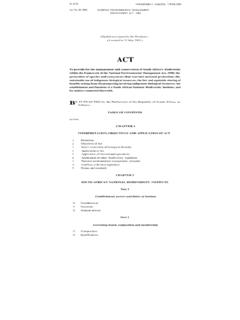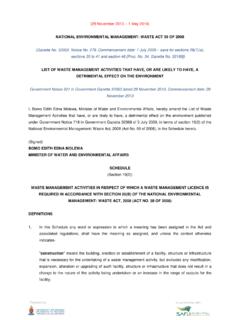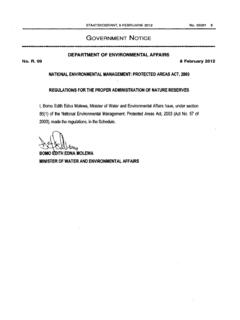Transcription of National Environmental Management: Waste Act: National ...
1 STAATSKOERANT, 24 JULIE 2009 No. 32439 3 GOVERNMENT NOTICE DEPARTMENT OF Environmental AFFAIRS No. 777 24 July 2009 National Environmental management : Waste ACT, 2008 (ACT NO. 59 OF 2008) National POLICY ON THERMAL TREATMENT OF GENERAL AND HAZARDOUS Waste I, Buyelwa Patience Sonjica, Minister of Water and Environmental Affairs, hereby publish for general information the National Policy on Thermal Treatment of G13neral and Hazardous Waste set out in the schedule hereto. / ~~~ LWA SONJICA TER OF WATER AND Environmental AFFAIRS SCHEDULE National POLICY ON THERMAL TREATMENT OF GENERAL AND HAZARDOUS Waste TABLE OF CONTENTS GLOSSARY OF TERMS.
2 3 ABBREVIATIONS .. 5 PURPOSE .. 6 VISION .. 6 IMPLEMENTATION .. 6 1. INTRODUCTION .. 7 2. BACKGROUND .. 7 3. INTERNATIONAL SITUATION .. 8 4. POLICY OBJECTIVES .. 9 5. EXISTING REGULA TORY FRAMEWORK .. 9 6. POLICY IMPLEMENTATION .. 11 7. KEY REFERENCE DOCUMENTS .. 11 4 No. 32439 GOVERNMENT GAZETfE, 24 JULY 2009 8. SCHEDULE 1: AIR EMISSION STANDARDS- Waste INCINERATION .. 13 9. SCHEDULE 2: AIR EMISSION STANDARDS-AFR CO PROCESSING .. 14 10. SCHEDULE 3: Waste EXCLUDED FROM CO-PROCESSING .. 16 11. SCHEDULE 4: CONDITIONS OF Environmental AUTHORISATION .. 17 2 STAATSKOERANT, 24 JULIE 2009 No. 32439 5 GLOSSARY OF TERMS Minister The Minister of Water and Environmental Affairs.
3 Department The National Department of Environmental Affairs. Alternative Fuels and Raw Materials (AFR) General and hazardous wastes which are used to substitute conventional or primary fossil fuels and/or virgin raw materials in cement kilns and other industrial processes {also referred to as 'Alternative fuels and resources', 'Secondary materials', 'Refuse derived fuel', or 'Solid recovered fuel'). Best Available Technique (BAT) The most effective and advanced stage in the development of activities and their methods of operation which indicate the practical suitability of particular techniques for providing in principle the basis for emission limit values designed to prevent and, where that is not practicable, generally to reduce emissions and impact on the environment as a whole.}
4 Be~t Environmental Practice (BEP) The application of the most appropriate combination of Environmental control measures and strategies. Best Practicable Environmental Option (BPEO) The option that provides the most benefit or causes the least damage to the environment as a whole, at a cost acceptable to society, in the long term as well as in the short term. By-product A substance that is produced as part of a process that is primarily intended to produce another substancE: or product and that has the characteristics of an equivalent virgin product or material. Co-Processing Utilisation of alternative fuels and/or raw materials in industrial processes for the purpose of energy and/or resource recovery and resultant reduction in the use of conventional fuels and/or raw materials through substitution.
5 Disposal The burial, deposit, discharge, abandoning, dumping, placing or release of any Waste into, or onto, any land. Environmentally Sound management (of Waste ) Taking of all practicable steps to ensure that Waste is managed in a manner that will protect health and the environment. Fossil Fuel Non-renewable, decayed organic materials that over time have formed geological deposits of carbon, such as oil, natural gas and coal, which are combustible and release energy through burning. General Waste Waste that does not pose an immediate hazard or threat to health or to the environment, and includes (a) domestic Waste , (b) building and demolition Waste , (c) business Waste , and (d) inert Waste .
6 3 6 GOVERNMENT GAZETTE, 24 JULY 2009 Greenhouse Gas (GHG) Natural and anthropogenic gasses such as methane, carbon dioxide and nitrous oxide that absorb and re-emit infra-red radiation in the atmosphere, thereby retaining heat and resulting in increased atmospheric temperatures. Hazardous Waste Any Waste that contains organic or inorganic elements or compounds that may, owing to the inherent physical, chemical or toxicological characteristics of that Waste , have a detrimental impact on health and the environment. Incineration Any method, technique or process to convert Waste to flue gases and residues by means of oxidation.
7 Recovery The controlled extraction of a material or the retrieval of energy from Waste to produce a product. Recycling A process where Waste is reclaimed for further use, which process involves the separation of Waste from a Waste stream for further use and the processing of that separated material as a product or raw material. Reduction Involves various possible measures to reduce the amount of Waste generated, manufacturing process optimisation, or raw material reduction or substitution. Re-use To utilise articles from the Waste stream again for a similar or different purpose without changing the form or properties of the articles.
8 Thermal Treatment Incineration, co-processing and other high temperature treatment of general and hazardous Waste . Treatment Any method, technique or process that is designed to (a) change the physical, biological or chemical character or composition of a Waste , or (b) remove, separate, concentrate or recover a hazardous or toxic component of a Waste , or (c) destroy or reduce the toxicity of a Waste , in order to minimise the impact of the Waste on the environment prior to further use or disposal. Waste Any substance, whether or not that substance can be reduced, re-used, recycled and recovered (a) that is surplus, unwanted, rejected, discarded, abandoned or disposed of, {b) which the generator has no further use of for the purposes of production, (c) that must be treated or disposed of, or (d) that is identified as a Waste by the Minister by notice in the Gazette, and includes Waste generated by the mining, medical or other sector, but {i) a by-product is not considered Waste , and {ii) any portion of Waste , once re-used, recycled and recovered, ceases to be Waste .}}}
9 Waste management Hierarchy The Waste management Hierarchy reflects the different Waste management options, from reduction (most preferred) through to re-use, recycling, recovery, treatment/destruction, and lastly disposal (least preferred), that should all form part of an integrated Waste management system. 4 STAATSKOERANT, 24 JULIE 2009 ABBREVIATIONS AFR: APPA: DEA: DWA: BAT: BEP: BPEO: ECA: EIA: GHG: IPWM: NEMA: NEM: AQA: NEM:WA: NWMS: POPs: Alternative Fuels and Raw Materials Atmospheric Pollution Prevention Act, 1965 (Act 45 of 1965) Department of Environmental Affairs Department of Water Affairs Best Available Techniques Best Environmental Practice Best Practicable Environmental Option Environment Conservation Act, 1989 (Act 73 of 1989) Environmental Impact Assessment Greenhouse Gas Integrated Pollution and Waste management National Environmental management Act, 1998 (Act 107 of 1998) National Environmental management : Air Quality Act, 2004 (Act 39 of 2004) National Environmental management : Waste Act.
10 2008 (Act 59 of 2008) National Waste management Strategy of South Africa (1999) Persistent Organic Pollutants No. 32439 7 5 8 GOVERNMENT GAZETIE, 24 JULY 2009 PURPOSE This policy dOCIJ ment presents Government's position on thermal Waste treatment as an acceptable Waste management option in South Africa, and provides the framework within which the following thermal Waste treatment technologies shall be implemented in the country: (i) The incineration of general and hazardous Waste in dedicated incinerators or other high temperature thermal treatment technologies, including but not limited to pyrolysis and gasification.









![National Environmental Management Act [No. 107 of 1998]](/cache/preview/3/8/3/c/e/f/0/e/thumb-383cef0e6349dc46a88a24f7331b59ae.jpg)